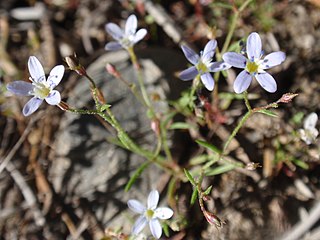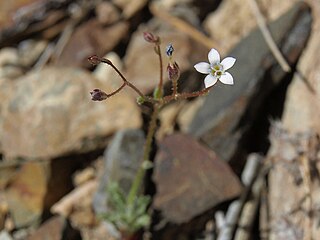
Gilia brecciarum is an annual flowering plant in the phlox family (Polemoniaceae), known by the common name Nevada gilia or break gilia.

Gilia cana is a species of flowering plant in the phlox family known by the common name showy gilia. It is native to California and Nevada where it grows in open areas with gravelly and sandy soils, such as desert and rocky slopes. The Mojave Desert range of some subspecies may extend into Arizona.

Gilia clivorum is a species of flowering plant in the phlox family known by the common names purplespot gilia and many-stemmed gilia. It is native to California and Arizona.
Gilia minor is a species of flowering plant in the phlox family known by the common name little gilia. It is native to the Mojave Desert and it is also present in the coastal Santa Lucia Mountains of central-southern coastal California.
Gilia ophthalmoides is a species of flowering plant in the phlox family known by the common name eyed gilia. It is native to the Southwestern United States where it can be found in woodlands and high desert plateau.

Gilia stellata is a species of flowering plant in the phlox family known by the common name star gilia. It is native to the southwestern United States and northern Mexico, where it is a common resident of desert washes and sandy mountain slopes.

Gilia aliquanta is a species of flowering plant in the phlox family known by the common name puffcalyx gilia. It is native to the Sierra Nevada mountains and deserts of southeastern California and southern Nevada.

Navarretia capillaris is a species of flowering plant in the phlox family known by the common name miniature gilia. It is native to the western United States where it grows in wet, gravel-lined habitat especially in mountains, such as snowmelt runs.

Gilia clokeyi is a species of flowering plant in the phlox family known by the common name Clokey's gilia. It is native to the south-western United States from California to Colorado, where it grows in desert and other habitat.
Gilia diegensis is a species of flowering plant in the phlox family known by the common name coastal gilia.
Linanthus filiformis is a species of flowering plant in the phlox family known by the common name yellow gilia. It is native to the southwestern United States, where it grows in rocky desert and plateau habitat. This herb produces a threadlike, branching stem not more than about 15 centimeters long. It is generally hairless but may be thinly dotted with glands. The few linear leaves are up to 3 centimeters long and occur along the stem. The inflorescence generally bears one pair of yellow flowers, each flower under a centimeter wide.

Aliciella leptomeria is a species of flowering plant in the phlox family known by the common names sand gilia and Great Basin gilia. It is native to the Western United States, where it grows in many types of habitat, such as the sagebrush of the Great Basin and in the Mojave Desert.

Linanthus maculatus is a species of flowering plant in the phlox family known by the common names San Bernardino Mountain gilia and Little San Bernardino Mountains gilia. It is endemic to California, where it is known only from a few locales in the Little San Bernardino Mountains and the adjacent Palm Springs area in the northern end of the Coachella Valley. The largest populations, which may contain thousands of individuals, are located within the bounds of Joshua Tree National Park. This is a very small annual herb no more than three centimeters high. It has a taproot which may exceed 6 centimeters in length to collect moisture from the dry desert sand in its native habitat. The tiny, hairy stem branches to form small matted clusters on the sand surface. The hairy leaves are just a few millimeters long and unlobed. The inflorescence is a dense cluster of flowers each only 2 to 5 millimeters wide. The flower corolla has curled-back lobes which are white, sometimes with a spot of purple or pink. The protruding stamens are yellow. The main threat to this species is development in its range, and it is also vulnerable to off-road vehicle damage in the wide open sandy flats where it grows.

Aliciella micromeria is a species of flowering plant in the phlox family known by the common name dainty gilia. It is native to the western United States, especially the Great Basin. It is a small herb producing a thin, branching stem up to about 14 centimeters tall. It is coated thinly in soft hairs. Several deeply lobed leaves 1 to 6 centimeters long are located in a basal rosette at ground level around the stem. There are smaller, unlobed leaves along the stem. The inflorescence produces white or lavender flowers each about 3 millimeters wide.
Aliciella subacaulis is a species of flowering plant in the phlox family known by the common name pinyon gilia. It is native to the western United States from California to Wyoming, where it grows in several types of habitat, such as sagebrush and desert woodlands. This herb produces a glandular stem up to about 30 centimeters tall, surrounded at the base by an erect cluster of lobed leaves each up to 7 centimeters long. There are also smaller, unlobed leaves along the stem. The inflorescence is a loose cluster of purple-washed white flowers with yellow-spotted throats.
Gilia transmontana is a species of flowering plant in the phlox family known by the common name transmontane gilia. It is native to the western United States from California to Utah, where it grows in desert and plateau habitat.

Nemacladus glanduliferus is a species of flowering plant in the bellflower family known by the common name glandular threadplant. It is native to the southwestern United States and Baja California, where it grows in desert and plateau habitat. It is an annual herb producing a purplish or brownish green, branching stem up to about 25 centimeters tall. Small oval leaves occur at the base of the plant. The inflorescence is a series of zigzagging branches bearing occasional flowers on thin, erect pedicels. There is a single small bract at the base of each pedicel. The flower at the curved tip of the pedicel is just a few millimeters wide. There are five pointed sepals and five white corolla lobes, generally three in the upper lip and two in the lower.
Gilia yorkii is a rare species of flowering plant in the phlox family known by the common names Boyden Cave gilia and monarch gilia. It is endemic to Fresno County, California, where it is known from only one location in the southern Sierra Nevada. This plant grows in rock cracks in the limestone cliffs and outcrops in the chaparral and woodlands of the canyon.
Saltugilia latimeri is an uncommon species of flowering plant in the phlox family known by the common name Latimer's woodland gilia. It is endemic to California, where it is known from several scattered occurrences in the western Mojave Desert and outlying areas to the north. It occurs in dry rocky and sandy desert canyons. It was first described as a species in 2001.

Saltugilia is a genus of flowering plants in the phlox family, Polemoniaceae. They are known commonly as woodland gilias. There are four species. Two are endemic to California in the United States, and the distributions of the other two extend into Baja California in Mexico.











